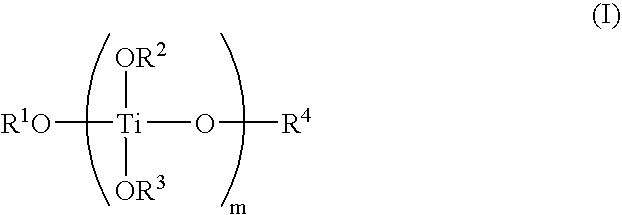Orthochromatic polyester resin composition and molding product thereof
a polyester resin and composition technology, applied in the direction of monocomponent polyester artificial filament, mixing, chemical apparatus and processes, etc., can solve the problems of foreign matter adhesion and deposited around the spinneret for melt spinning, decrease in formability of polymer melt, fuzz and/or breakage of filament yarn obtained, etc., to achieve excellent formability and mechanical and chemical performance, good color, and bright color
- Summary
- Abstract
- Description
- Claims
- Application Information
AI Technical Summary
Benefits of technology
Problems solved by technology
Method used
Image
Examples
referential example 1
[0110] Synthesis of Titanium Catalyst A
[0111] A solution of 0.2% by mass of trimellitic anhydride in ethylene glycol was mixed with tetra-n-butoxytitanium in an amount of ½ mole per mole of trimellitic anhydride. The mixture was subjected to a reaction for 60 minutes by keeping it at a temperature of 80° C. in the air atmosphere under the ambient atmospheric pressure. Then the resultant reaction mixture was cooled to room temperature, and the resultant catalyst was recrystallized with acetone in an amount of ten times the reaction mixture. The resultant precipitation was collected by filtration with a filtering paper, and dried at 100° C. for 2 hours, to obtain the desired compound. The resultant compound will be referred to as titanium catalyst A hereinafter.
referential example 2
[0112] Synthesis of Titanium Catalyst B
[0113] Mono-n-butyl phosphate in an amount of 3.5 parts by mass was dissolved in 131 parts by mass of ethylene glycol by heating the mixture thereof at 120° C. for 10 minutes. The resultant ethylene glycol solution in an amount of 134.5 parts by mass was further mixed with 40 parts by mass of ethyleneglycol and in the resultant solution, 3.8 parts by mass of tetra-n-butoxytitanium were dissolved. The resultant reaction mixture liquid was stirred at 120° C. for 60 minutes to react the titanium compound with mono-n-butyl phosphate. A white aqueous slurry of a catalyst containing the resultant reaction product was obtained. In the catalyst slurry, the titanium content was 0.3% by mass and the molar ratio Mp / MTi of the phosphorus element to the titanium element was 2.0. As a result of further detailed analysis, it was confirmed that the catalyst in the white slurry was a compound represented by the general formula (III) wherein X represents a n-bu...
referential example 3
[0114] Measurement of Visible Light Absorption Spectrum of Tinting Agent
[0115] Preparation of Tinting Agents
[0116] A solution of each coloring matter shown in Table 1 in chloroform was prepared in a concentration of 20 mg / liter at room temperature, and a quartz cell having an optical path length of 1 cm was filled with the solution. A reference cell was filled with chloroform alone. The cell and the reference cell were subjected to a measurement of visible light absorption spectra in a visible light wavelength band of from 380 to 780 nm by using a spectrophotometer, model: U-3010, made by K.K. Hitachi Seisakusho. In the case where two tinting agents are used in mixture thereof, the total concentration was adjusted to 20 mg / liter. The ratio of an absorbance of each solution at a wavelength of 400, 500, 600 or 700 nm to an absorbance of each solution at a maximum absorption wavelength was calculated. Also, the thermal mass reduction-initiating temperature of each tinting agent in th...
PUM
| Property | Measurement | Unit |
|---|---|---|
| Temperature | aaaaa | aaaaa |
| Length | aaaaa | aaaaa |
| Fraction | aaaaa | aaaaa |
Abstract
Description
Claims
Application Information
 Login to View More
Login to View More - R&D
- Intellectual Property
- Life Sciences
- Materials
- Tech Scout
- Unparalleled Data Quality
- Higher Quality Content
- 60% Fewer Hallucinations
Browse by: Latest US Patents, China's latest patents, Technical Efficacy Thesaurus, Application Domain, Technology Topic, Popular Technical Reports.
© 2025 PatSnap. All rights reserved.Legal|Privacy policy|Modern Slavery Act Transparency Statement|Sitemap|About US| Contact US: help@patsnap.com



